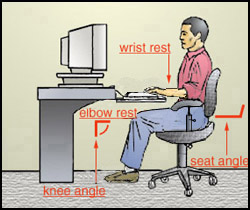Office Ergonomics
You probably don’t pay a lot of attention to “office ergonomics” – the physical relationship between you and your office equipment. But if you ignore the basics, you’re not only risking discomfort… you’re also risking decreased productivity.
It’s hard to imagine getting along without computers today. Many of us spend hours at the keyboard – at home and at work. A computer allows us to do most of our work sitting in one place for extended periods of time.
Muscles, tendons and joints put up with it for a while, then they give us feedback in the form of stiffness or in the form of aches and pains. This can happen in our arms, wrists, shoulders or back.

Discomfort may start as fatigue, mild soreness or numbness. It can develop into chronic pain that doesn’t go away and when it finally does it flares up more quickly and acutely.
If you suffer such discomfort, it is probably because (1) blood circulation in your muscles is poor while you’re working and (2) you are holding stressful body positions for long periods of time.
Muscles are made for moving! Body movement circulates important oxygen and nutrients to muscle tissue. Strong muscles can be tensed and held without movement, for example when arm wrestling, but if “static” muscle contraction continues for very long, a substance called lactic acid is produced in muscle tissue, causing pain.
This can happen over long periods of time when you ask your muscles to “hold you up” in your chair; “hold your head erect;” and hold your hands “suspended” over the keyboard or the mouse.
A lack of active movement and healthy blood circulation often leads to muscle fatigue. It is particularly harmful if your arm must reach out from your body for long periods of time, to manipulate the mouse.
What to do about the problem? Move! Stretch! Take breaks! Stretch again! Keep blood circulating through the chain of muscles in your upper body. Stretch! Shoulders and upper back seem particularly vulnerable, so shrug, roll, and move them around often. Do this before your body starts shouting at you!
Put your joints in “neutral!” If the wrist is not maintained in a “neutral” position during prolonged computer use, operators may suffer maladies such as Carpal Tunnel Syndrome.
Neutral, in this case, means the wrist must not be bent up or down, to one side or the other, while fingering the keys or using the mouse. In very simple terms, a bent wrist can “pinch” nerves in the wrist over time, causing nerve damage and chronic pain. “Neutral” also applies to other parts of the body, which should be kept in the least stressful working position-with minimal effort needed to hold them there.
What to do about work position problems? Raise, lower or re-position your keyboard, to keep your wrist in a neutral position and your elbows positioned close to your body. Obtain one of the many hand or wrist supports that help achieve the same goal.
Locate the mouse in close proximity to the keyboard, so you won’t have to reach out, or arrange your work area so your working forearm rests on the surface of the desk. Raise the level of the monitor so your head rests squarely on your shoulders, and your neck and upper back muscles won’t strain to hold it erect.
Here are four easy ways to improve your ergonomics.
EYES: Should be 24 to 36 inches from the monitor screen. The top of your monitor should be below or at eye-level.
FEET: Should be on a footrest or planted firmly on the floor.
SITTING: To reduce vertebrae pressure and minimize lower back pain, sit in a slightly reclined position in your chair. Making this work may mean using a cordless keyboard or one with a long cord.
DESK: Most desktops are 28 to 30 inches above the floor. This is too high for computer work, so you’ll need to lower your keyboard and mouse. It’s easy to install an adjustable keyboard and mouse tray on the underside of your desk. The keyboard should be at a negative tilt, with the front edge slightly lower than the rear.